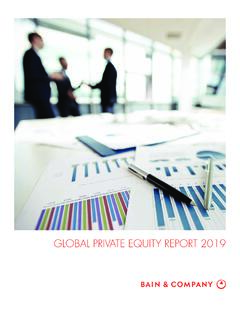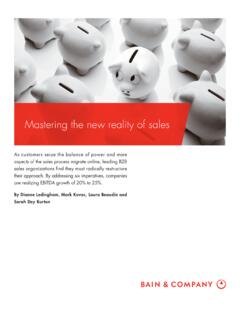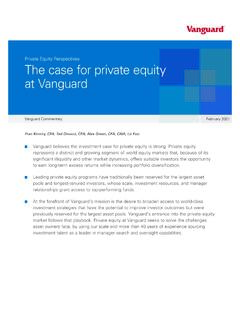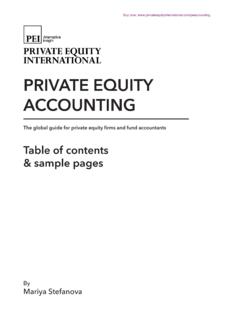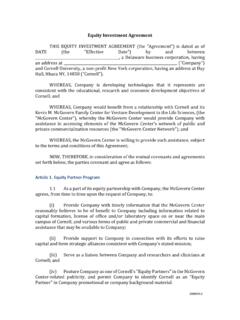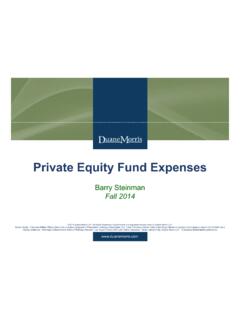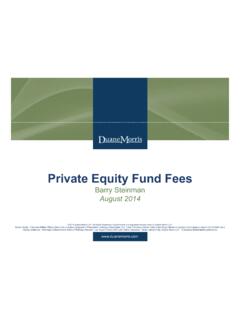Transcription of GLOBAL PRIVATE EQUITY REPORT 2019 - Bain & Company
1 GLOBAL PRIVATE EQUITY REPORT 2019 About Bain & Company s PRIVATE EQUITY businessBain & Company is the leading consulting partner to the PRIVATE EQUITY (PE) industry and its stake-holders. PE consulting at Bain has grown eightfold over the past 15 years and now represents about one quarter of the firm s GLOBAL business. We maintain a GLOBAL network of more than 1,000 experienced professionals serving PE clients. Our practice is more than triple the size of the next largest consulting Company serving PE s work with PE firms spans fund types, including buyout, infrastructure, real estate and debt. We also work with hedge funds, as well as many of the most prominent institutional investors, including sovereign wealth funds, pension funds, endowments and family investment offices. We support our clients across a broad range of objectives:Deal generation. We help develop differentiated investment theses and enhance deal flow by profiling industries, screening companies and devising a plan to approach diligence.
2 We help support better deal decisions by performing integrated due diligence to assess the market dynamics, a target s competitive position and margin expansion opportunities, and by providing a post-acquisition post-acquisition. We support the pursuit of rapid returns by developing a strategic value-creation plan for the acquired Company , leading workshops that align management with strategic pri-orities, and directing focused initiatives or wholesale value addition. We help increase Company value by supporting revenue enhancement and cost reduction and by refreshing We help ensure that funds maximize returns by identifying the optimal exit strategy, preparing the selling documents and prequalifying strategy and operations. We help PE firms develop distinctive ways to achieve continued excel-lence by devising differentiated strategies, maximizing investment capabilities, developing sector specialization and intelligence, enhancing fund-raising, improving organizational design and deci-sion making, and enlisting top investor strategy.
3 We help institutional investors develop best-in-class investment programs across asset classes, including PRIVATE EQUITY , infrastructure and real estate. Topics we address cover asset class allocation, portfolio construction and manager selection, governance and risk management, and organizational design and decision making. We also help institutional investors expand their par-ticipation in PRIVATE EQUITY , including through coinvestment and direct investing & Company , Inc. 131 Dartmouth Street Boston, Massachusetts 02116 USA Tel: +1 617 572 2000 GLOBAL PRIVATE EQUITY REPORT 2019iContentsThe beginning of the rest of the story?..pg ..11. The PRIVATE EQUITY market in 2018: What happened?..pg ..3 Investments:. ,..pg .. :..pg ..13 Exits:..pg ..17 Fund-raising:..pg .. :..pg ..27 Returns:. ,..pg ..pg ..362. What s happening now: The strategies shaping PRIVATE EQUITY in 2019 and beyond..pg ..37 Buy-and-build.
4 ,..pg .. :..pg .. :..pg .. :..pg ..673. PRIVATE multiples are ascendant: Is this the new normal?..pg ..73 GLOBAL PRIVATE EQUITY REPORT 2019iiGlobal PRIVATE EQUITY REPORT 20191 The beginning of the rest of the story?Dear Colleague:The past five years have been ones of unprecedented success for the PRIVATE EQUITY industry. During that span, more money has been raised, invested and distributed back to investors than in any other period in the industry s history. PRIVATE investment in general, and PRIVATE EQUITY in particular, seems to be on a secular penetration curve that has no end in sight. Yet, there are also some cautionary notes to sound. Returns, while still strong relative to other asset classes, have slowly declined toward public market aver-ages during the period. Persistent high prices, volatile capital markets, US China trade arguments, Brexit worries and, of course, the ever-present threat of recession have injected a sense of uncertainty that deal-makers dislike.
5 The pace of technological change is also increasing in almost every industry, making it harder to forecast winners and losers. So, while the good times are rolling, some bells of worry are this, Bain s 10th-anniversary GLOBAL PRIVATE EQUITY REPORT , we look fearlessly at the industry s strengths, its challenges and the evolutionary path that lies ahead. In addition to the critical statistics that characterize PE industry performance, you ll find our assessment of how to do buy-and-builds properly and why this tactic is increasing in popularity. Building on last year s assertion that PE firms need to increase their 10% share of the approximately 40,000 M&A deals done globally each year, we discuss how firms are building merger integration muscles to better compete with corporate buyers, and why the integration process should begin during due diligence. We also take a hard look at adja-cency strategy and the new wave of EQUITY products that many PE firms are moving into aggres-sively, hoping to find higher returns and more productive ways to invest capital at addition, we zero in on exciting topics such as advanced analytics, which speeds insight in both diligence and post-close value addition; liquidity solutions for general partners; and the Chinese PE market, which is on the leading edge in areas like close our 2019 review of important trends in PRIVATE EQUITY by getting out our crystal ball.
6 It s a bit cloudy (as is everyone s), but we see fundamental shifts happening in capital markets that are likely to drive a long-term trend toward much larger PRIVATE capital (and PRIVATE EQUITY ) opportunities vs. traditional public EQUITY models. This ongoing movement will have seismic impacts for providers of capital, investors of that capital and for the companies owned by a widening variety of PRIVATE models. It portends a future in which a much larger share of capital flows into PRIVATE markets. Perhaps this is indeed the beginning of the rest of the story for the PE industry. Hugh MacArthur Head of GLOBAL PRIVATE EquityGlobal PRIVATE EQUITY REPORT 20192 GLOBAL PRIVATE EQUITY REPORT 201931. The PRIVATE EQUITY market in 2018: What happened?As the current economic expansion chugged into its ninth full year in 2018, the GLOBAL PRIVATE EQUITY (PE) industry continued to make deals, find exits and raise capital at a historic five-year pace.
7 Limited partners (LPs) remain highly enthusiastic and have continued to flood the market with fresh capital. Keeping the momentum going, however, has hardly been easy. Chronically heavy competition has driven deal multiples to historic highs, and growing jitters about an eventual economic downturn are affecting decision making, from diligence to exit planning. For general partners (GPs), putting record amounts of capital to work means getting comfortable with a certain level of discomfort when investing. They are paying prices they swore they would never pay and looking to capture value that may prove elusive post-close. The most effective GPs are stepping up their game to identify targets and sharpen diligence, while simultaneously planning for the worst. In Sections 2 and 3, we ll explore several strategies firms are using to make the most of an increasingly difficult market. In the meantime, here s what happened in 2018.
8 Investments: More strength, same challengesAmid heavy pressure to do deals, the PE industry saw another impressive surge in investment value in 2018. Fierce competition and rising asset prices continued to constrain deal count pushing down the number of individual transactions by 13%, to 2,936 worldwide but total buyout value jumped 10% to $582 billion (including add-on deals), capping the strongest five-year run in the industry s history (see Figure ). While the current investment cycle hasn t been a steady upward march, especially in terms of deal count, it has shown great resilience and overall strength. Every year since 2014 has produced higher deal value than any year in the previous cycle, with the exception of the peak in 2006 and 2007. Over this period, the industry has benefited from an unprecedented wave of investor interest, buttressed by ebullient EQUITY markets, low interest rates and steady GDP growth in the US and Europe.
9 For GPs, it has been a remarkable , experts are debating how long the good times can last. Only one other US recovery on record (from 1991 to 2001) has extended as long as this one. While GDP growth in the West remains strong, US interest rates are rising as inflation picks up in the US and Europe. Slowing growth in China, GLOBAL trade tensions, ongoing uncertainty about Brexit and year-end market volatility are all fueling concern that this cycle may be running its course. For PE firms, however, the question isn t so much when the next downturn will appear as how to nego-tiate it successfully when it does. With record amounts of capital to invest, it doesn t pay to sit idle trying to time the downturn. Instead, GPs are finding ways to cope with a growing level of macro uncertainty GLOBAL PRIVATE EQUITY REPORT 20194and planning carefully for how they can profit from the downturn. With the GLOBAL financial crisis fresh in their memories, firms are focusing their diligence much more intently on downside scenarios this time around.
10 They learned valuable lessons during the crisis about what holds up well through the cycle or not and are adjusting accordingly. Even within a sector like healthcare, widely viewed as recession-resistant, there were subsector differences in performance worth noting. Healthcare support services, for instance, produced multiples of better than two times invested capital, while healthcare equipment and pharmaceuticals fared less well, according to CEPRES, a digital investment platform and transactional network for the PRIVATE capital markets (see Figure ). Spotting pockets of opportunity has been a challenge even in the up-cycle. For GPs, finding the right asset at the right price was the biggest constraint on doing deals in 2018. That helps explain why the number of transactions has remained stubbornly flat, bouncing around between 3,000 and 4,000 buyouts per year since 2010. Indeed, despite the industry s impressive showing over the last five years, it has failed to carve out a larger share of the GLOBAL market for mergers and acquisitions, which has hovered around 40,000 transactions per year for a decade (see Figure ).
